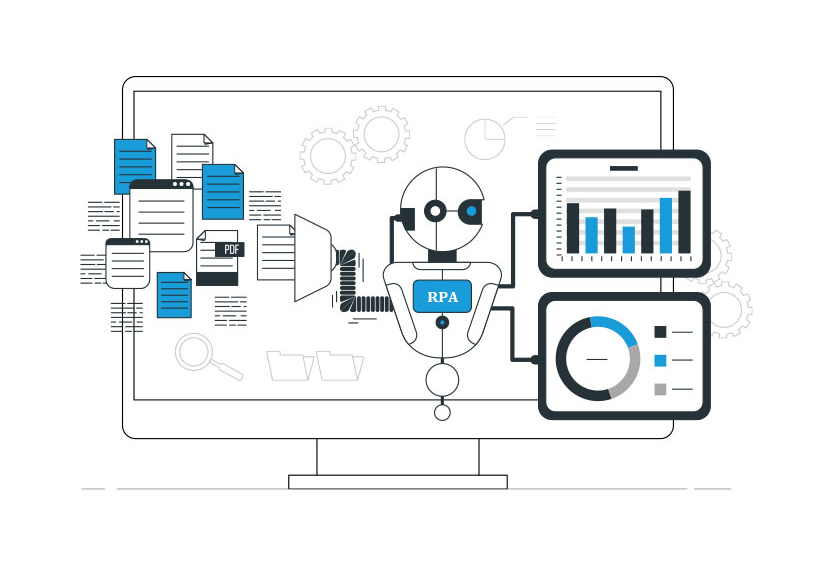Article on RPA
ROBOTIC PROCESS AUTOMATION (RPA)
Let’s take an example. There is an accountant in an organization. He handles several invoices & other financial records like monitoring transactions, liabilities, cheques and ledger on daily basis. One of his tasks is to copy all the relevant information’s from these invoices such as Name of the Company, Invoice ID, and Date of Processing into a spreadsheet and mail the sheet along with the financial reports to the superiors by the end of the day. As any prompt employee, he transfers all the information to the sheet, attaches the report, and sends the reports to his boss or email every day. But, over a period he starts finding this tasks to be time consuming & repetitive. First way, he looks for a way to reduce the time and after that it takes to complete the task. Then, he stumbles across Robotic Process Automation. With the help of RPA, he builds a simple bot that extracts information from several invoices into an excel sheet, attaches all the necessary financial reports and send them over to the superior via email at a specific time every day.
What exactly is Robotic Process Automation?

Robotic Process Automation (RPA) is the use of software technology without Artificial Intelligence and Machine Learning capabilities to handle high volume repetitive tasks that previously required humans to perform. It is very easy to build, deploy, & manage software bots that follow human’s actions interacting with the digital systems and software. Just like normal people, software robots can do things such as understanding what’s on a screen, navigate systems, identifying and extracting data’s, and perform a wide range of defined actions. As a result, the software robots can do it faster and more consistently than people, without the need to get up or take a coffee break. Some of these automated tasks include Addressing queries, Making calculations, Maintenance of records and performing transactions.
Automation v/s Robotic Process Automation
Automation already existed even before RPA came into existence. Unlike RPA, Automation is the creation of a new technology to solve real-life problems with the need for human intervention.
| PARAMETER | AUTOMATION | RPA |
|---|---|---|
| What does it Reduce? | Reduces execution time | Reduces the number of people working on something. |
| What does it automate? | Automates repetitive test cases i.e a product | Automates the repetitive business process i.e product as well as business |
| Programming Knowledge | Programming knowledge required to create test scripts | Programming knowledge is mostly not needed as it is wizard-driven |
| Software Environment | Limited software environment | A wide range of software environments |
| Application | Used for QA, Production, Performance, UAT environments | Usually used in production environments |
Lifecycle of Robotic Process Automation
Basically, Robotic Process Automation (RPA) has four crucial phases:
- Analysis – Gathering the processes to be automated, identifying the test objects, finalizing the implementation of the approach
- Bot Development - Creation of automation workflows for the requirements
- Testing - Run testing cycles such as SDLC to verify the quality and correct defects
- Support & Maintenance - After development & testing phase, a bot enters the maintenance phase in which it provides continuous support & helps in the immediate defect resolution.
Robotic Process Automation Tools
There are different tools available in the market, each providing various functionalities according to our need. But, among all of them, the top 3 tools in today’s market are the trio - UiPath, Blue Prism, and Automation Anywhere.
| FEATURES | UIPATH | BLUE PRISM | AUTOMATION ANYWHERE |
|---|---|---|---|
| Is trial version available? | Community edition/ Free edition is available | No trial version available | Trial version is available for 30 days |
| Is it user-friendly? | Provides user-friendly visual designer | Provides a user-friendly visual designer, easier than Automation Anywhere | Developer’s friendly but requires high programming skills. |
| Popularity | Most Popular tool | More popular than Automation Anywhere | Least popular tool in the trio |
Usage of RPA
Besides imitating human actions, repeating high volume tasks and performing multiple tasks at once.
- Automate the Report Generation – Makes accurate and timely reports by automating the process of extracting data.
- Reduces the gap between systems - Reduces the gap by preventing custom implementations.
- Assurance of quality - Delivers quality product by performing testing and automating customer use case scenarios.
- Cross-check information - Data across various systems is cross- verified to validate the information.
- Data Migration - Unlike traditional systems, RPA allows automated data migration through systems.
- Forecasting Revenue - Updates financial statements to predict revenue forecast automatically.
- Virtual system integration - Automated systems transfer data between disparate and legacy systems by connecting them at user interface level.
Business Benefits of Robotic Process Automation
RPA streamlines different workflows, which makes organizations more flexible, profitable and responsive which in return increases employee satisfaction, engagement, & productivity by removing boring tasks from their workdays.
Robotic Process Automation is noninvasive and can be easily and rapidly implemented to fast-track digital transformation. RPA is also used for automating workflows that involve legacy systems that lack APIs, virtual desktop infrastructures (VDIs), or database access.
Some of the business benefits are:
- Fast-track transformation
- Greater resilience
- Higher accuracy
- Improved compliance
- Boosted productivity
- More value from personnel
- Happier employees
Robotic Process Automation: fastest - growing enterprise solution?
- Rapid, significant return on investment (ROI)
- Minimal upfront investment
- No disruption to underlying systems
- Low-code build environment
- Scalable and enterprise ready
Join Famark Community!
Famark community is a social platform for creative and innovative professionals from different domains.
Join Community